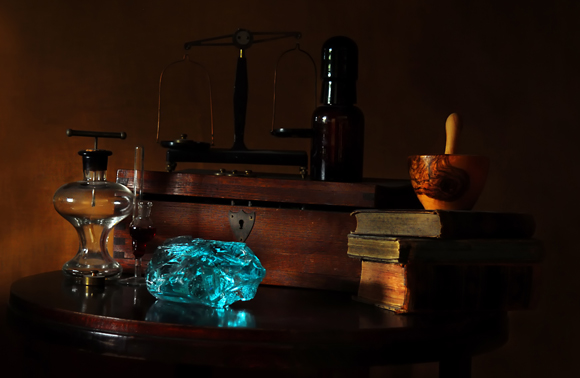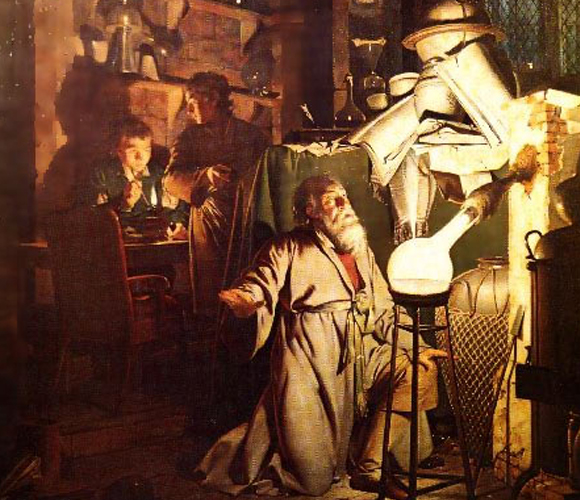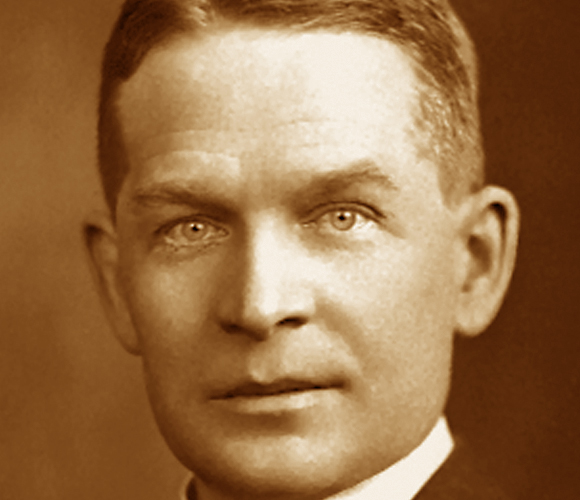Generations of alchemists attempted to make gold out of cheaper metals. Modern science has shown that all you really need is an exploding star, or at least a particle accelerator
In Greek mythology, everything King Midas touched turned into gold. It was called “the Midas touch,” a term used to describe a knack for making money in every business venture or greed. Midas’ story is a testimonial to humanity’s obsession for this special metal. For thousands of years, gold symbolized wealth and formed the basis for global economy and trade. It aroused curiosity and greed in people of both science and spirit, who tried for years to make the Midas touch a reality by turning other materials, considered to be of lesser value, into gold. These attempts, collectively called alchemy, failed. But can today’s knowledge and technology make an ancient dream come true?

The Midas touch became synonymous with economic success. Midas and his daughter in a drawing by Nathaniel Hawthorne, 1893. Source: Wikipedia public domain
From “sick” metals to gold
Alchemy is a pre-scientific field of study that was widespread up until the Middle Ages, and focused on the nature of materials and the reactions between them. Alchemy combined philosophical beliefs, like the belief held by Greek philosopher Aristotle, according to which every material in nature strives for perfection. The most perfect material, according to alchemists, was gold. Besides its unique color, gold can withstand other materials and environments, and it is easy to weld and shape. Alchemists thought, like Aristotle, that other materials, such as lead and iron, are inferior and “sick.” They believed these could be “cured” and turned into the coveted gold in a process called “transmutation”.
Alchemists’ experiments were based on the premise that each material in nature is a combination of four basic elements – water, air, fire, and earth – thus, manipulating these ingredients can lead to the creation of new materials. In the Arabic world, a widely accepted theory was that each metal is made of sulphur, mercury, and salt, in different ratios. The attempts to make gold on the basis of these beliefs produced materials that were similar to gold in color and shape, but not real gold.
The holy grail of alchemy was a legendary material called the Philosopher’s Stone, which could change any material into gold. But the Philosopher’s Stone was never found, and all alchemy efforts failed. Eventually, it became clear that alchemy was fundamentally wrong, and it was replaced with scientific chemistry.

Alchemists could not find the stone that would make gold production possible. The Philosopher’s Stone. Illustration: Shutterstock
Adding and subtracting of protons
With the development of science, scientists came to discover that all the materials in nature are made of atoms, and that atoms are made of three components: Protons and neutrons in the nucleus, and electrons that orbit the nucleus. Chemical elements are defined by the number of protons in the nucleus of their atoms. That is the “atomic number,” which appears above the symbol of each element in the periodic table. For example, every atom that has only one proton is a hydrogen atom, and every atom that has 79 protons will be a gold atom. This information was not available to alchemists, but today, we can conclude that transmutation is indeed possible, and if we add protons to or remove protons from a nucleus, we’ll end up with different elements.

No knowledge of atomic structure. An alchemist and his assistant at work, painting by Joseph Wright. Source: Wikipedia, public domain
The fusion reactors of the periodic table
Nuclear fusion processes require large amounts of energy. Energy like that can be found, for example, in the cores of stars. In such environments, transmutation happens all the time, when light elements, like hydrogen and helium, are fused together, turning into heavier elements, usually up to iron, whose atomic number is 26. Making elements heavier than iron requires more energy, which is released only on rare events of supernova, or the “death” of a star, which is accompanied by an explosion and massive radiation. These heavier elements exist on Earth because remnants of supernovas have landed on it over billions of years.
Element formation occurs on Earth as well, in processes of “radioactive decay.” These processes work in the opposite direction, that is, they involve the degradation of heavy elements into lighter ones. In certain atoms, the nucleus is radioactive and unstable, a property usually linked to the number of neutrons in the nucleus. A radioactive atom stabilizes only after emitting energetic radiation, which is sometimes accompanied by conversion of one type of subatomic particle into another, such as protons to neutrons.. type of radioactive decay occurs in the formation of argon in the Earth’s atmosphere from radioactive potassium atoms . Energy production in nuclear reactors is based on nuclear fission, where radioactive uranium breaks down to lighter elements, including xenon and strontium.

Gold will cost a lot more money. British scientist Frederick Soddy, a radiochemist pioneer. Source: Wikipedia, public domain
Physics is the new alchemy
It’s difficult to control the results of these radioactive processes, but the technological developments and invention of particle accelerators have given humanity the ability to conduct artificial transmutation for the first time. By accelerating a neutron beam to a speed close to that of light and projecting it on a metal sheet, protons can be torn out of metal atoms and turned into atoms of other elements. The age-old vision of alchemists was revived in the 1940s, when researchers used this method to make gold atoms from mercury, whose atoms have one more proton than those of gold. Similarly, in 1980, other researchers made gold from bismuth, which has four more protons than gold.
However, this success was mostly theoretical, because the amount of gold created in these experiments was small. Furthermore, the gold created was mostly radioactive, so it was dangerous to humans. A gold atom has 79 protons, but also 118 neutrons that stabilize its nucleus. The gold atoms created in the particle accelerator had a surplus of neutrons, which decayed radioactively over a few days, turning the atoms into different elements.
There’s also the question of cost: Using a particle accelerator in the 1980s cost $5,000 per hour; according to one of the project managers, David Morrissey, the researchers used the equipment for an entire day only to create a small amount of gold – while the price of one gram of gold (as of March 2020), is around $52.
Frederick Soddy, a well-known English radiochemist in the early 20th century, estimated that artificial production of gold would not be practical: “If man ever achieved this further control over Nature, it is quite certain that the last thing he would want to do would be to turn lead or mercury into gold – for the sake of gold.” In other words, transmutation into gold is a process that is not worth the investment, and with the existing technologies today does not provide a return on investment. Meanwhile, let us manage with the resources nature offers, at least until future technologies will allow otherwise.
